A project schedule is a document that outlines the tasks to be accomplished before, during, and after a project.
It highlights the tasks, the individuals who handle each task, the deadline, and the resources needed to complete them. In addition, this document will give you the commencement and due date.
The primary purpose is to guide and help the team plan, execute, and monitor the progress of the project at hand. This schedule keeps your team on track and ensures they are entirely focused on the project.
A template for it provides a basis and structure for you to create a schedule for your project. This template will allow you to add all the critical components. You can separately include the phases and the individual tasks that will be handled during the project. The essence of a template is to help you plan, monitor, and execute the tasks at hand. With this template, you can adjust your schedule based on the tasks being handled and the challenges encountered during the project.
Project Schedule Templates
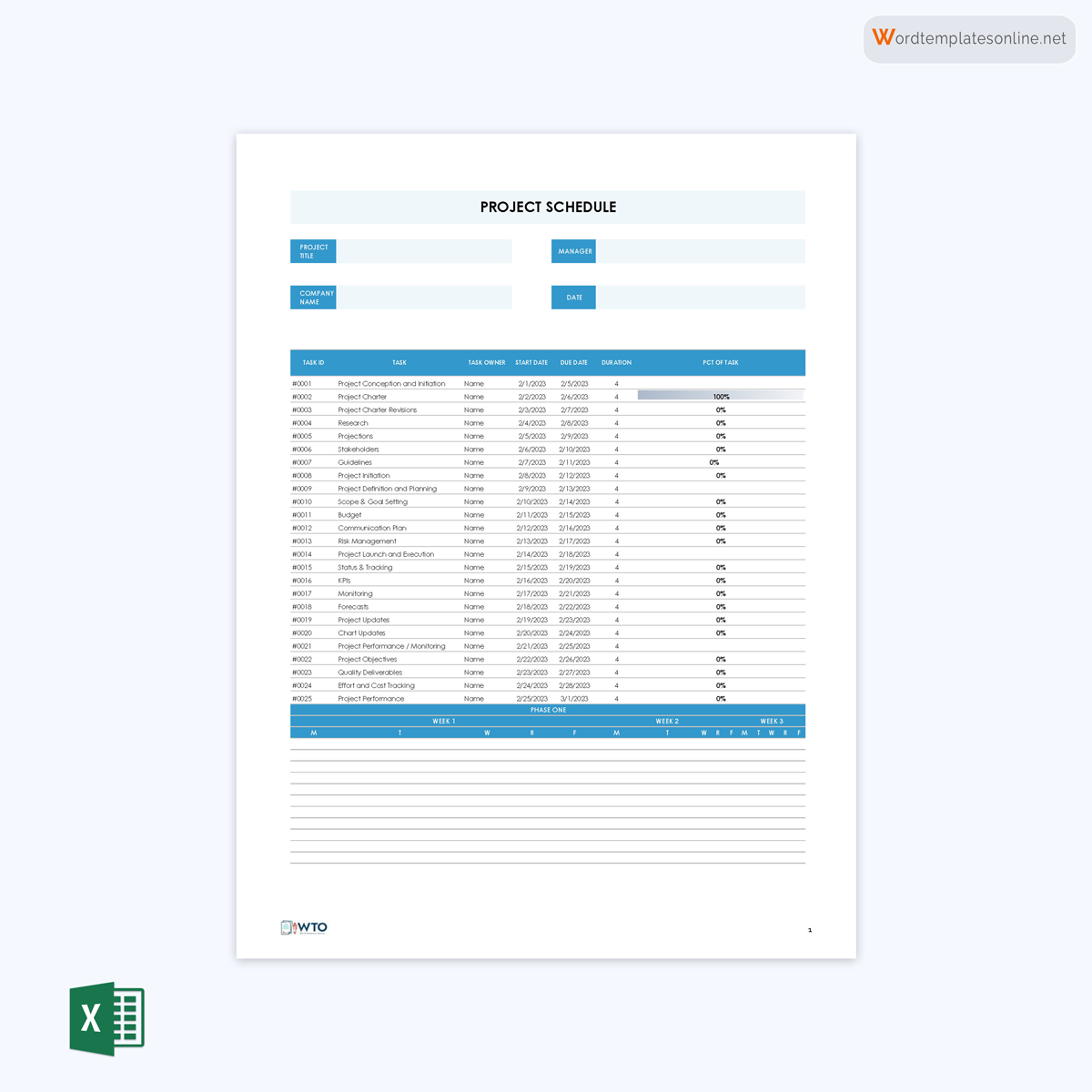
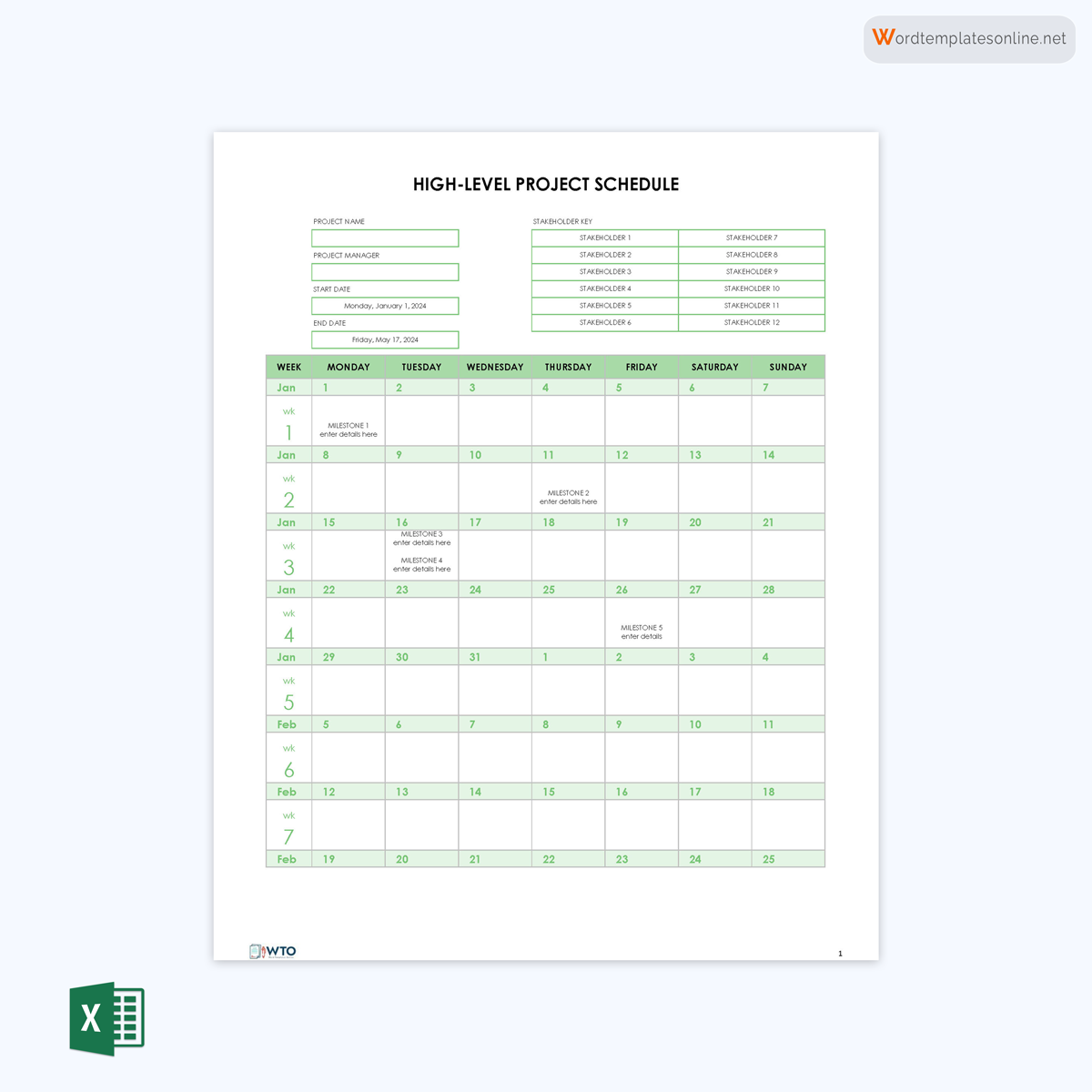
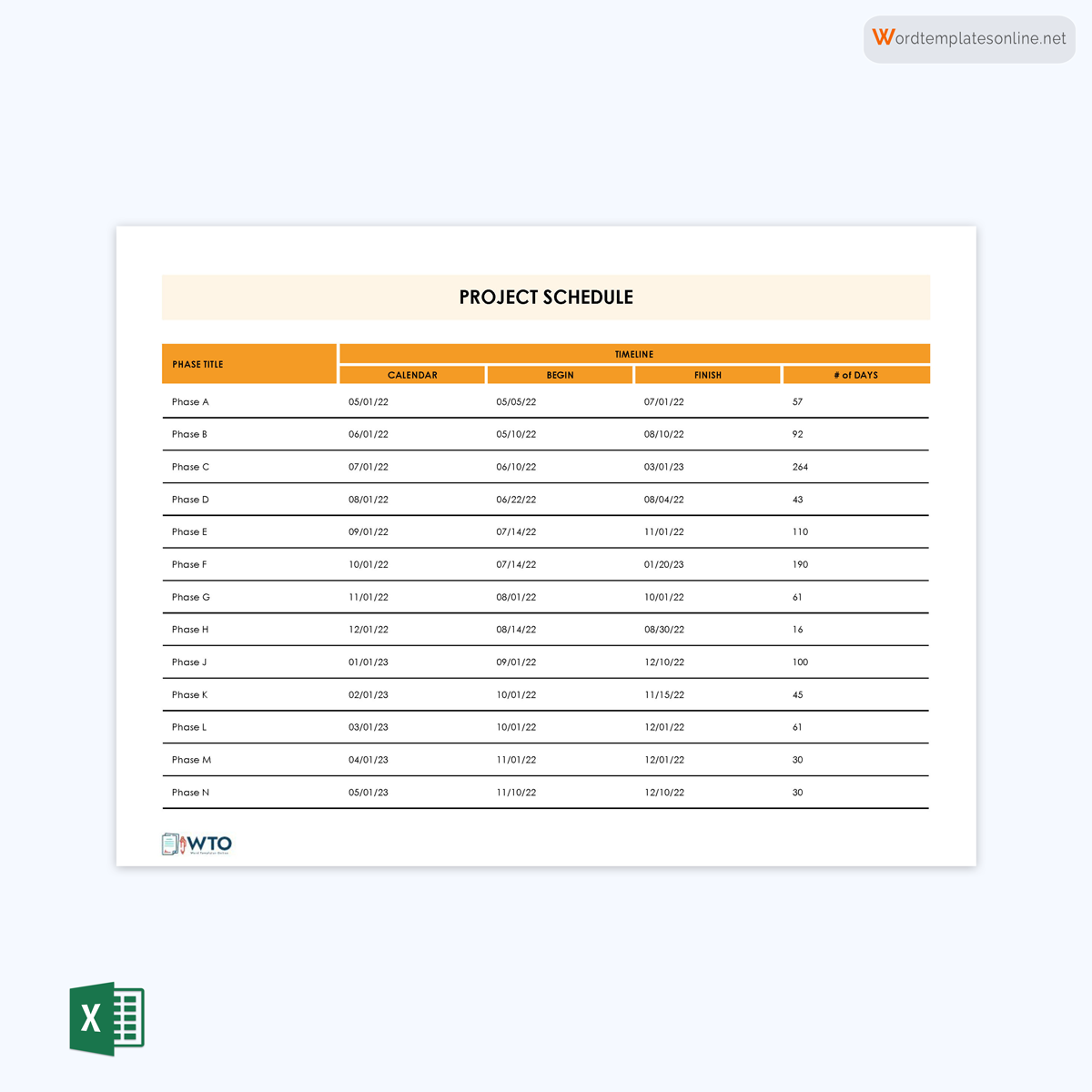
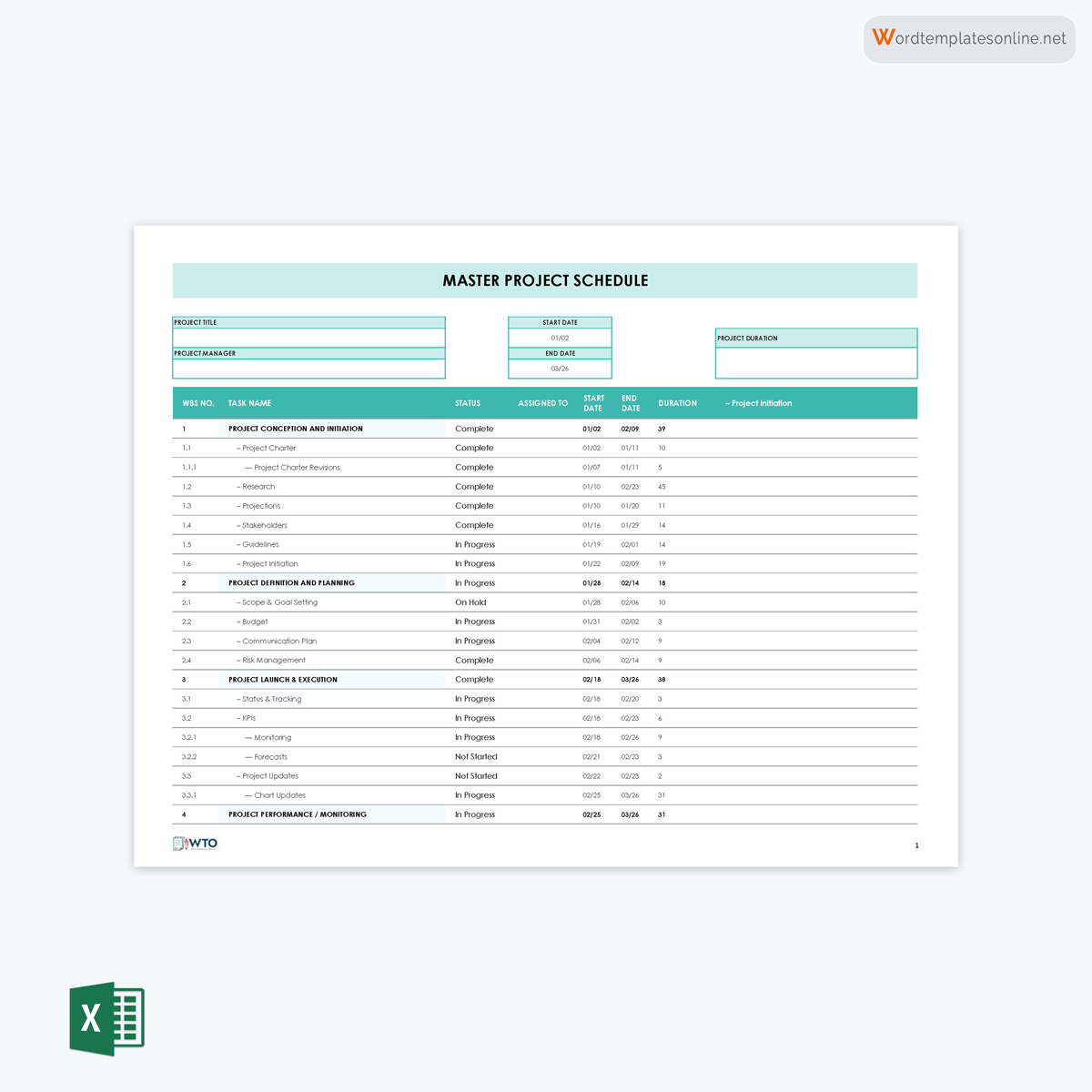

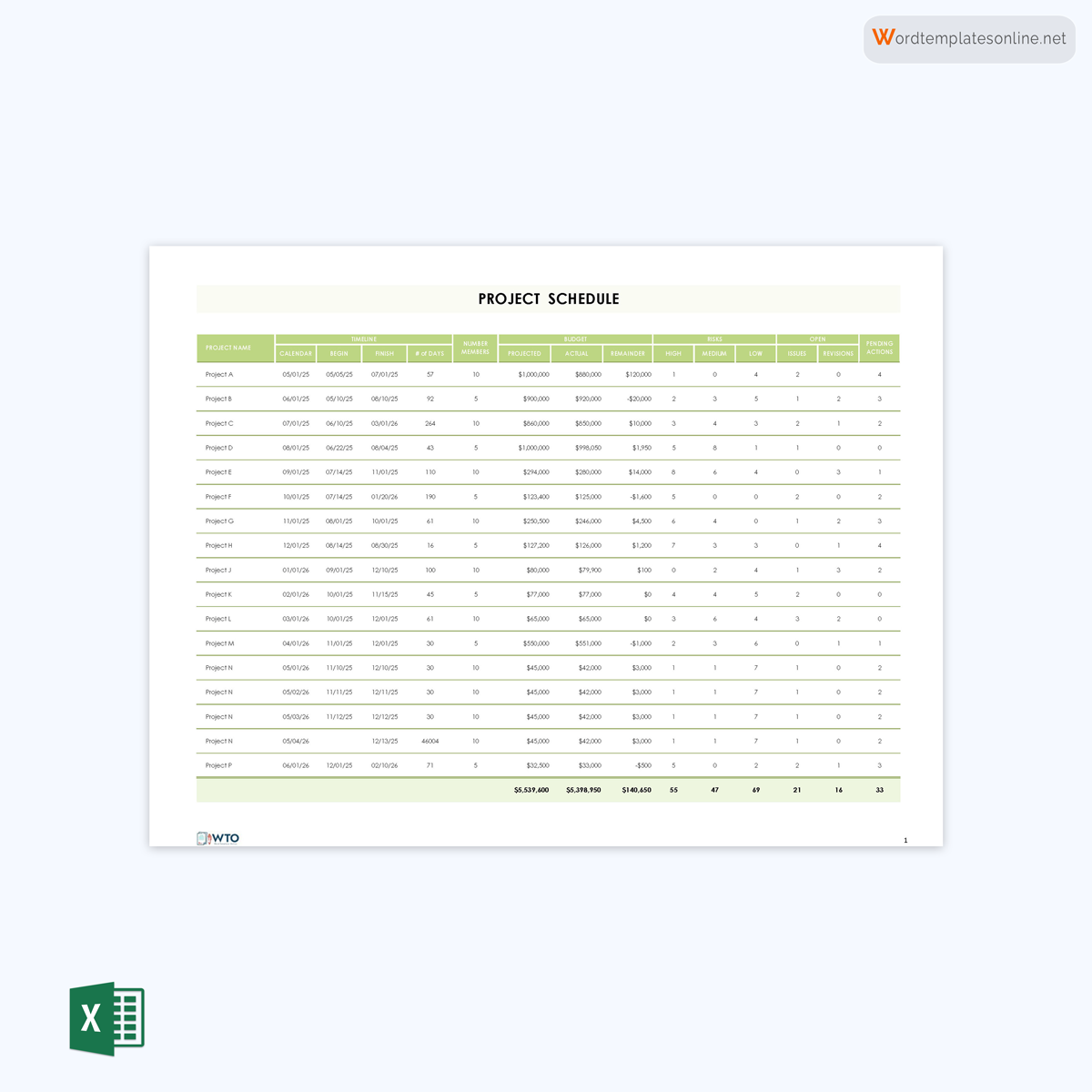
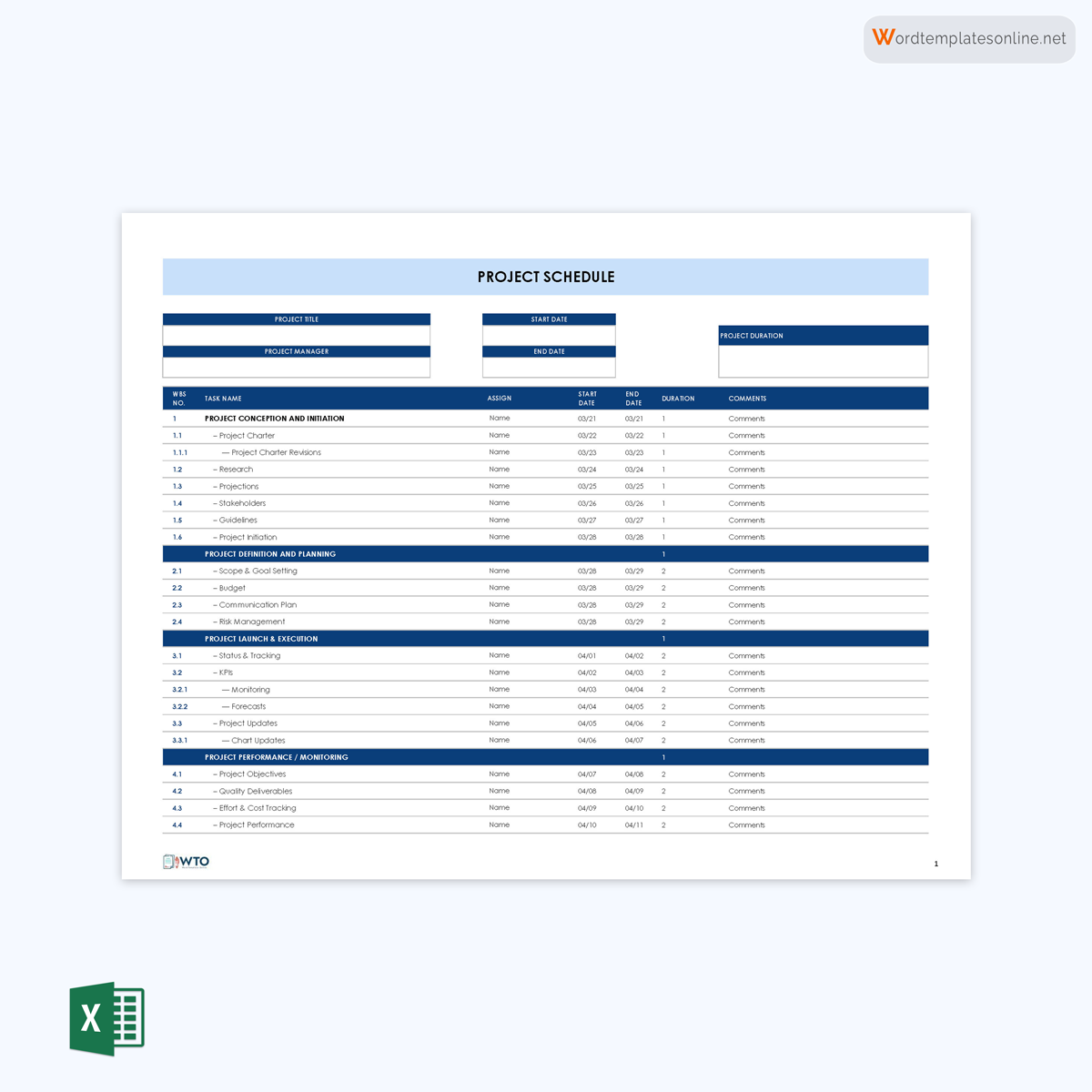
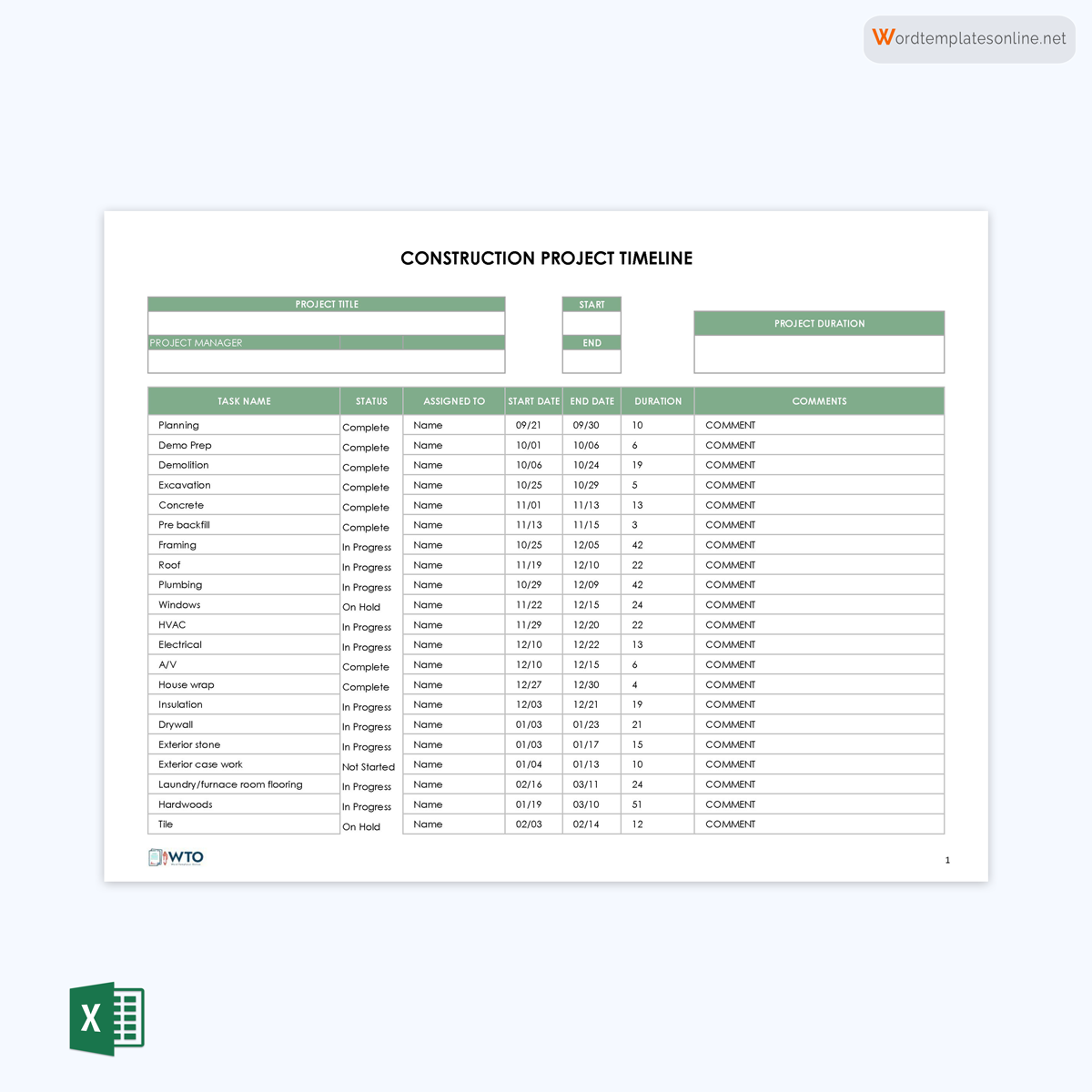
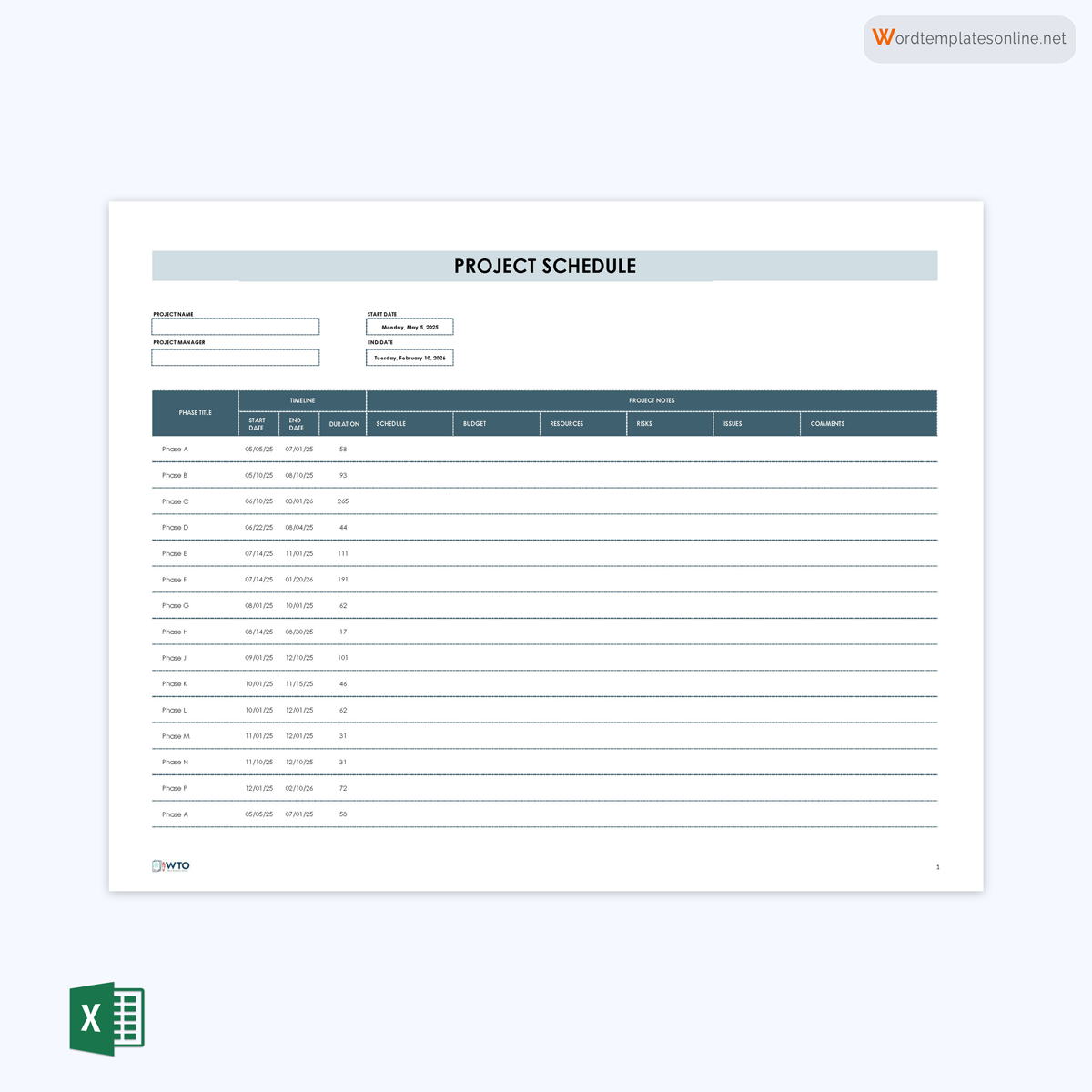
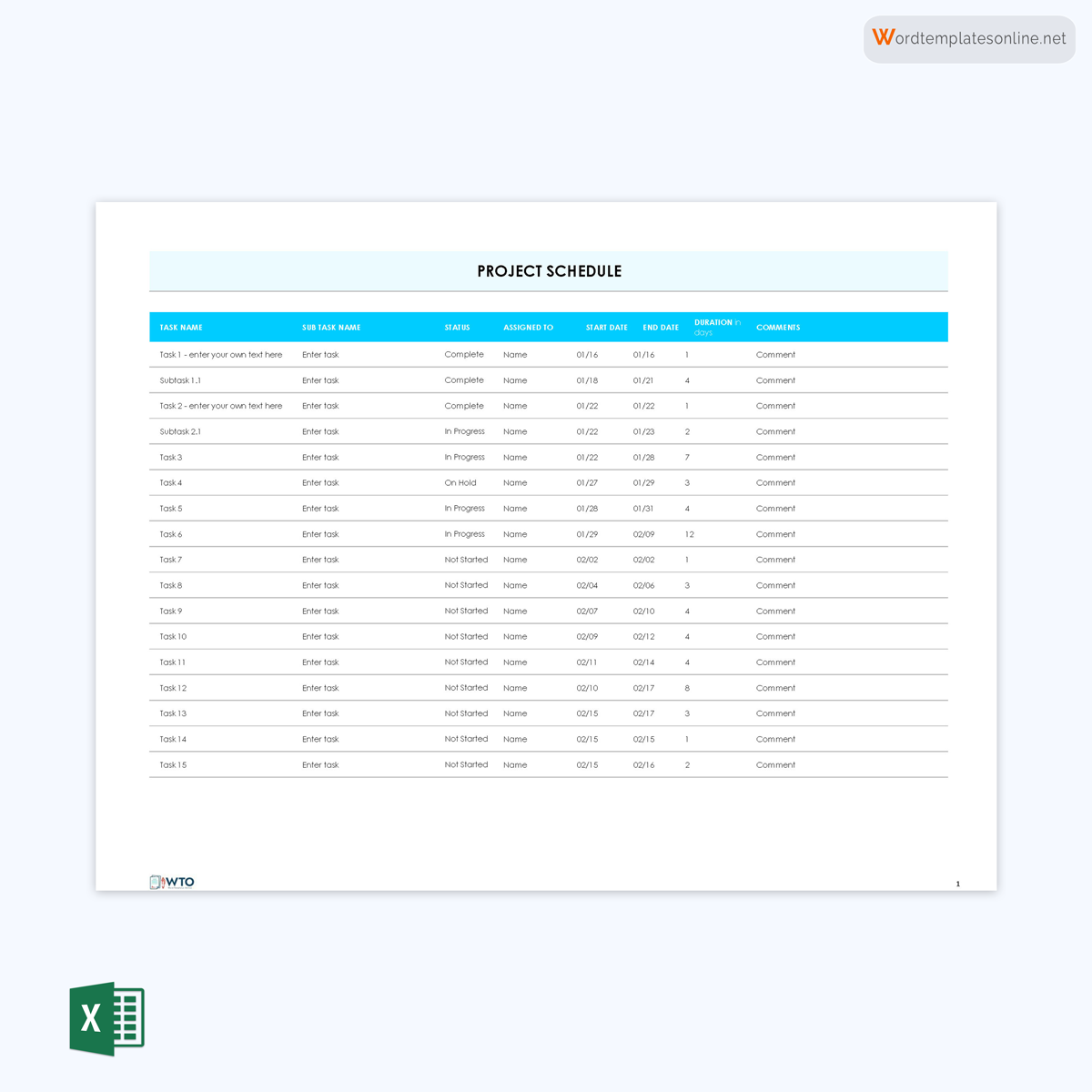
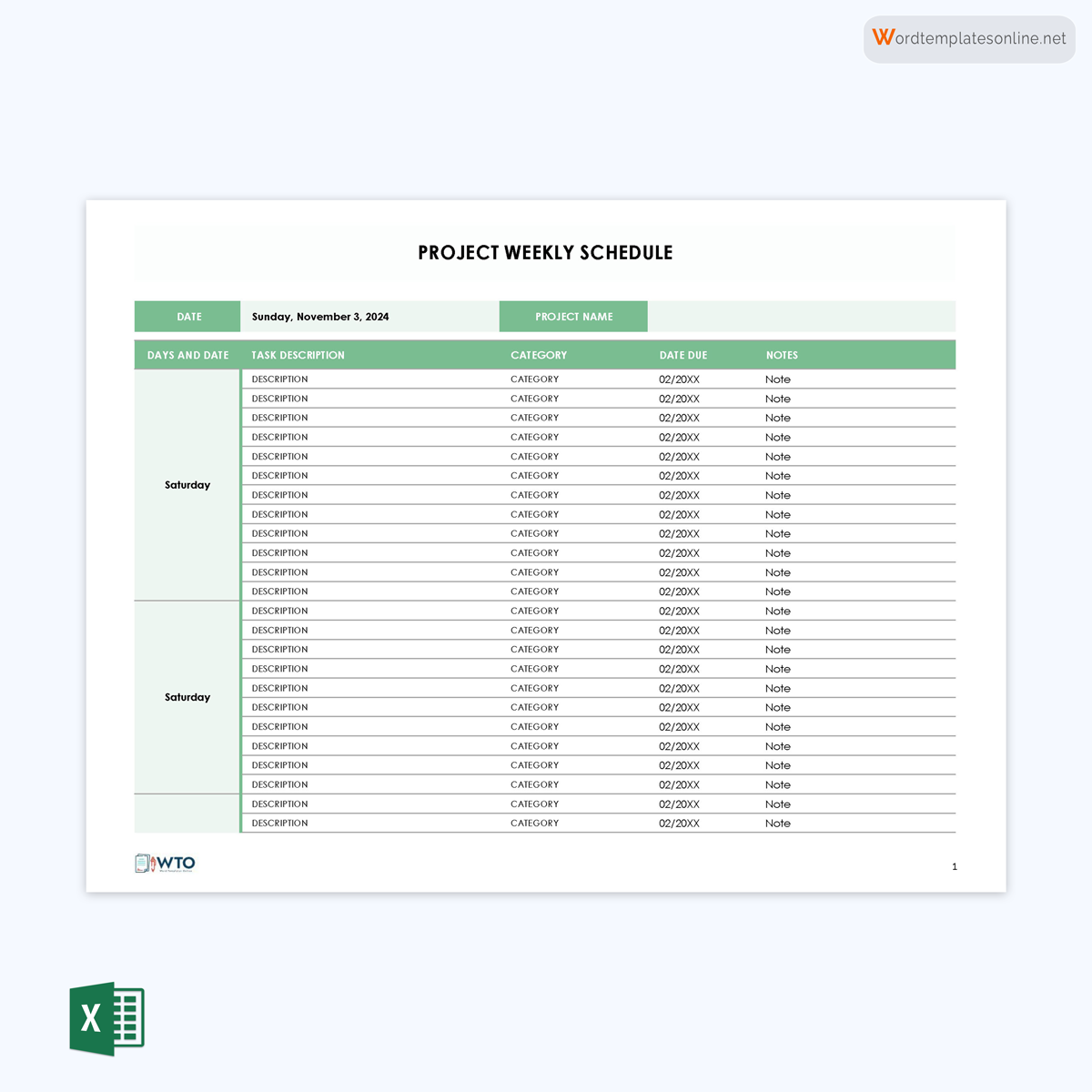
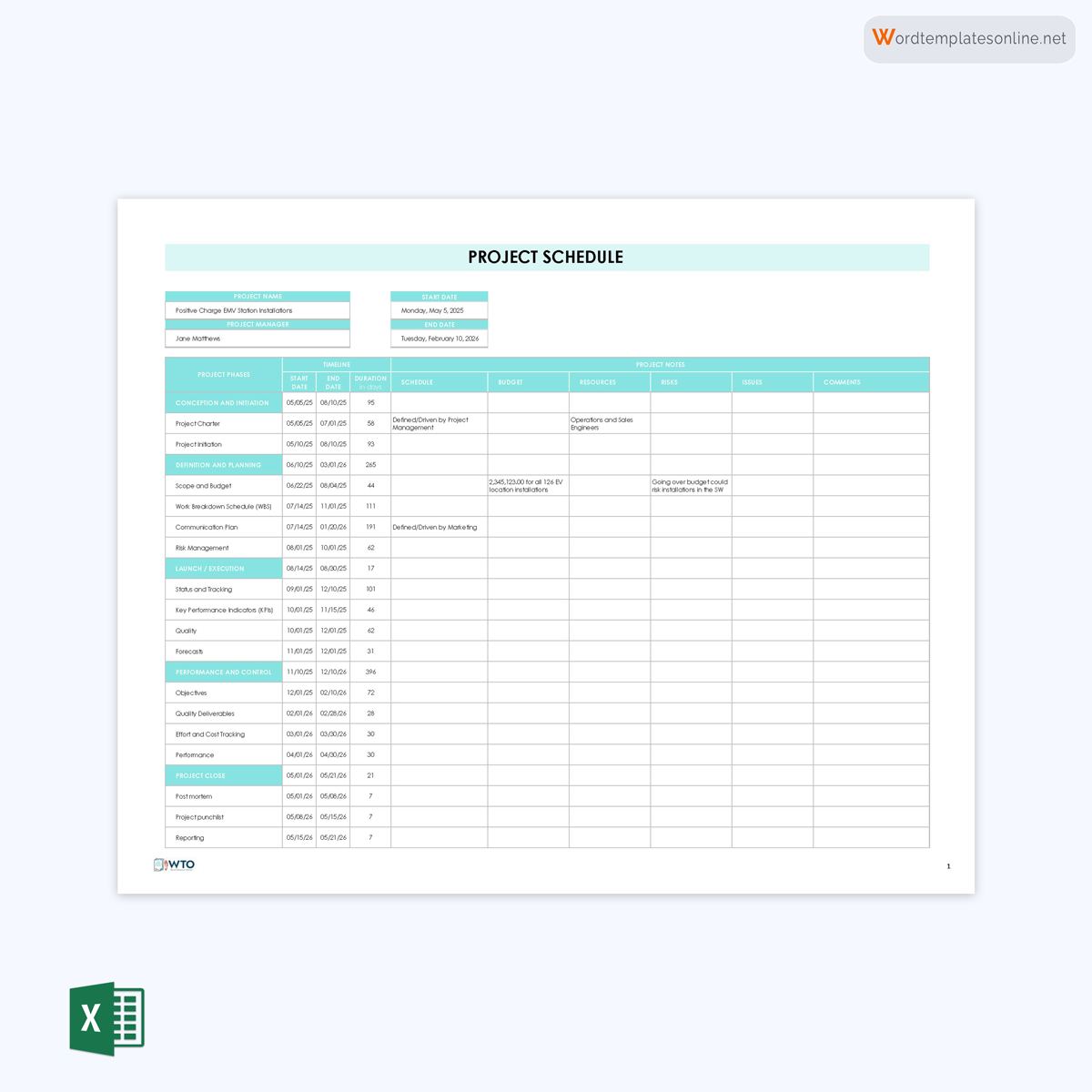
Who Prepares a Project Schedule?
Commonly, the manager is responsible for creating a project schedule. Therefore, the manager should create a realistic timeline and an achievable task schedule. But then again, a project usually comprises different departments. Therefore, the manager should consult other entities, like the team leaders, stakeholders, product managers, and the development team, to see if the created schedule complements the project.
Why is Creating a Project Schedule Important?
A project schedule is necessary, as it allows you and your workforce to stay focused and meet the set timeline.
Here are reasons why creating this schedule is essential when it comes to accomplishing tasks and achieving the objectives:
Increases efficiency and productivity
Scheduling is a good way of ensuring everyone is aware of what should be done. This means that everyone involved in the project will know what and when it needs to be done and the expected outcome. Additionally, it will help you divide tasks depending on their urgency. This will make it easy for the workforce to complete these tasks promptly.
Therefore, a schedule will allow you to track the project’s progress. This will allow you and your team to make the necessary adjustments to meet the deadlines. This will improve the efficiency and productivity of everyone working on the project.
Helps to save time
When dealing with a project, time is always a key factor. In most cases, managers always push their employees to complete the assigned tasks on time. Therefore, scheduling is an effective way of managing time. Scheduling lets you know the urgency of the available tasks and how to assign them.
Additionally, you can assign tasks to different employees with a project schedule. This will allow you to complete several tasks within a short period of time. Also, you will be able to keep track of these assignments based on their deadlines. This will make the project run smoothly and save you time.
Aids in prioritization of tasks
When handling a project, specific tasks will need to be prioritized. With a schedule, you will have a list of all the tasks to be handled. With this, you will deduce essential tasks that need to be handled urgently.
Furthermore, it will allow you to assign tasks whose deadlines are quickly approaching. This will ensure that you are always on track with the project’s progress. Additionally, you will be able to avoid making errors that may result from unnecessary rush and pressure.
Helpful in managing the workforce
When working on a project, you need the correct number of qualified individuals to handle the available tasks. Therefore, scheduling helps you avoid hiring too many individuals (over-staffing) or a few employees (understaffing).
This will allow your employees to handle these tasks effectively and efficiently to ensure they are completed on time. In addition, you can track and manage your workforce by increasing or decreasing the number of employees to suit the task.
Strengthens teamwork
Teamwork is a critical factor in the success of any project. Scheduling will ensure everyone has the same ideas and agrees with what should happen. This will make communication from the top to the bottom of the hierarchy swift and smooth.
As a result, this will create a team that understands what needs to be done, when to do it, and the resources needed. Teamwork will prevent unnecessary arguments that may delay and hinder the project’s progress. In addition, the team members can refer to the schedule if they need clarification about the task.
Helps in the evaluation of the work
As the project continues, tracking and knowing the progress made can become challenging, primarily if several tasks are handled simultaneously. However, with a schedule, you can check off the tasks already done or those in progress. By doing this, you will quickly know the progress made.
If you know the progress made, you can evaluate if the work follows the expected outcome. This is possible with a well-prepared schedule. With this, you will satisfy the project’s demands and meet the expectations of the executives and investors.
Improves marketing
As a manager, your reputation and work status heavily depend on the project’s success. Note that it is easy to market a successful project. You can schedule social media marketing programs that will allow you to reach out to other investors and connect with the target audience.
Clarifies everything
Projects can be complex and challenging, especially if they are significant and long-term. However, a project schedule simplifies everything by outlining the tasks and when they should be handled.
As the schedule might change as the project progresses, it is an efficient way of putting everything in order and ensuring that it starts on a good note.
Identifies dependency issues
With a schedule, you can identify the project tasks early. This gives you adequate time to examine the anticipated outcome of the tasks. Additionally, you will have time to prepare for any possible errors and challenges as you progress with the project. This way, you will find sustainable solutions early, before they become serious.
Project Schedule Vs. Project Plan Vs. SOW
A project schedule is a document that outlines the steps to follow to complete a project successfully.
It highlights the plans to follow, the resources needed, the duration given to the project, and any other requirements. In addition, it identifies the tasks to be completed, the individuals to complete these tasks, and when these tasks should be completed.
A project plan explains how the project will be managed and executed.
The plan includes the tasks to be handled and the best ways to handle these tasks. Additionally, the plan will mention the suitable individuals to handle the available tasks. With the project plan, you can control and execute different phases. The plan will allow for risk management programs, clear communication channels, a resource management plan, project scope, and quality control methods.
The scope of work (SOW) details the objectives of the project.
This outlines what is to be done during the project and the expected outcome. A scope of work is a document highlighting a contractual agreement between all the parties involved. The document also shows the resources to be used, the payments agreed upon, and the terms and conditions of the project.
An SOW ensures that the project’s objectives and expected results are listed before its commencement. This way, all the involved parties will know what is expected and work towards attaining it.
How to Create a Project Schedule
A project schedule is crucial to the success of the project. Therefore, it should be created carefully while involving all the necessary players.
Here is a guide on how to create a schedule that will make your project a success:
Identify the project’s goals
When starting a project, it is essential to identify and clarify what needs to be achieved. First, outline what the project is all about and identify what needs to be done to make the project a success. It is essential to center the project’s objectives on its vision and mission.
This will help you achieve realistic and attainable goals for the project. In addition, the goals will act as a basis for the commencement and progress of the project.
Identify the stakeholders
Stakeholders are individuals who are directly involved in the project and have an influence on how it will transpire. These individuals may include executives and employees. These individuals are either participating in the project or being updated on its progress. As a result, the project schedule should have a communication plan that allows the free flow of information from the executives to the employees.
Define and create a list of activities
The project activities are tasks handled and completed by a set of qualified individuals. As a manager, you are responsible for outlining and defining the activities to be handled during the project. You can do this by listing the activities and the resources assigned to each activity.
Additionally, you can consult the experts regarding the project at hand. This will help you understand what you are dealing with and allow you to accurately define the activities of your team. It is also necessary to involve your workforce when creating a project schedule. This will help them grasp what needs to be done and be conversant with the project’s activities.
List out milestones
The essence of a project schedule is to help you break down large tasks into sub-tasks assigned to your team. Therefore, it is necessary to have a list of goals to be achieved at the end of the project. Hence, the broken-down tasks will enable you to attain these targets. In addition, this breakdown will allow your team to work effectively and efficiently toward meeting the set objectives.
Listing out the milestones is an effective way of keeping track of project progress. Note that this is an effective way to keep the workforce motivated; this will also show that the project is headed in the right direction.
Look for task dependencies and create a sequence
With the activity list in place, you need to focus on the sequence in which you handle the activities. This will let you know the urgent tasks that should be handled first before handling other tasks. Then, with the tasks at hand, you can start working on tasks that depend on each other. These are tasks where one task must be completed for the next one to begin.
To make this process swift, you can assign beginning and ending dates for each task or sub-task. In addition, dependencies are easier to handle when they are appropriately scheduled and assigned to the right team members.
Estimate task time and effort
It is essential to estimate and assign sufficient time to each task. This is particularly crucial if you are dealing with an unfamiliar project. This will allow you and your team to understand the project and devise the perfect ways to handle the available tasks.
Techniques for estimating the time
If you are struggling to find a perfect time estimate for the tasks at hand, the following methods can help you and your team handle the available tasks promptly:
- Use an unfamiliar multiplier: This is a rule where you add between 50-100% of the estimated time to unfamiliar tasks. This will give you enough time to evaluate and handle these tasks.
- Add some float: There are instances where a task might take longer than expected. In this case, you can intervene before this ruins your schedule. Most people refer to this as ‘float.’
Assign the tasks to the team members
With a well-prepared schedule, you will have a list of tasks to be handled throughout the project. Also, you will know which tasks need urgent and utmost attention. As a result, you can assign the available tasks to a qualified team.
Note that you must be keen on the time given to the assigned tasks. Also, the schedule will allow you to spread the tasks across different teams. This will prevent you from overloading a team of employees with tasks.
Come up with a plan for updating the project schedule
It is crucial to update and make changes to the project schedule constantly. This allows you to see the progress and tasks that need more attention. Additionally, updating the schedule will allow the executives and stakeholders to see the progress made on the project.
You can update the schedule manually, or you can use an online platform that is efficient, effective, and more secure. Updating allows you to add, remove, or change certain aspects of the project.
Methods to Show Tasks, their Sequence, and Time
When writing a project schedule, there are several techniques you can use to effectively outline the tasks, their sequence, and the time assigned to each task.
Below are methods you can use:
Gantt Chart method
A Gantt chart is a method used to illustrate and display the whole project in one view.
This method allows you to traditionally compile all tasks, activities, and milestones in one place. With a Gantt chart, you will visualize all the tasks handled during the project. This allows you to see the entire project from start to finish in one view. Usually, a Gantt chart is created based on the objectives.
In the Gantt chart method, the sequence of the project tasks and phases is depicted using bars and charts; this starts at the top left corner of the chart and ends at the bottom right corner. This is an effective way of seeing the overall project schedule, progress made, and milestones.
Additionally, you will quickly spot the dependencies and any potential issues hindering the project. Finally, this method allows you to estimate the time needed to complete the tasks and the project.
Network diagram
This is a standard method among project managers. A network diagram allows you to interconnect the tasks and activities visually. These diagrams show how the project activities relate to each other. In addition, the network diagram outlines the best way of arranging the available tasks in a network format. This makes it easy for you to correctly assign the tasks and identify the independent and dependent ones.
Failure to include any task or activity in the network may alter the cost, duration, and outcome. Therefore, it is crucial to be accurate when creating a network diagram for your project. In addition, this method informs the workforce of the sequence to use when handling the tasks and when each task should begin and end.
The critical path
This is a method used to highlight the sequence in which the tasks should be handled. Additionally, it points out the shortest possible period the project should take to be completed. A critical path is usually depicted in a table that shows all the project activities. In most cases, this method shows the urgency of each task.
A critical path effectively allows scheduling dependencies and gaining control. To identify a critical path, you must calculate how long each task will take. The critical path is essential as it allows you to prepare for any risks before, during, and after the project.
Tips to Consider
A project schedule should be perfect for minimizing errors. There are specific tips to consider when creating a project schedule.
Below are some tips you can consider:
Plan with your team
This is an effective way of ensuring that all parties involved are focused on attaining the project objectives. In addition, this means that all members will be aware of what is required of them, thereby successfully keeping them informed about every aspect of the project.
Cover the scope of the project
Reviewing and covering the project statement is necessary. This will allow you and your team to understand what is expected at the end of the project.
Match resources and skills with tasks
It is crucial to allocate the right resources to the available tasks. This will allow you to attain the set objectives and save money and time. Furthermore, with the right resources, it is guaranteed that the project will be a success.
Measure the progress
A schedule allows you to keep track of the project’s progress. This acts as a motivating factor for the employees and the executives. Additionally, measuring the project’s progress allows you to prepare for the next task on schedule. With this, you will know whether you will meet the deadline.
Find out if you can help
As a manager, evaluating every task and seeing if you can offer help is essential. As a manager, you are also responsible for ensuring the project’s success. Therefore, your expertise and skills may be beneficial to ensuring the task is completed perfectly and on time.
Check-in regularly
Checking in and constantly updating the project schedule is crucial. This is an effective way of adding or removing any unnecessary information from the schedule. Additionally, you will be able to get regular updates from your team regarding the tasks being handled and those completed.
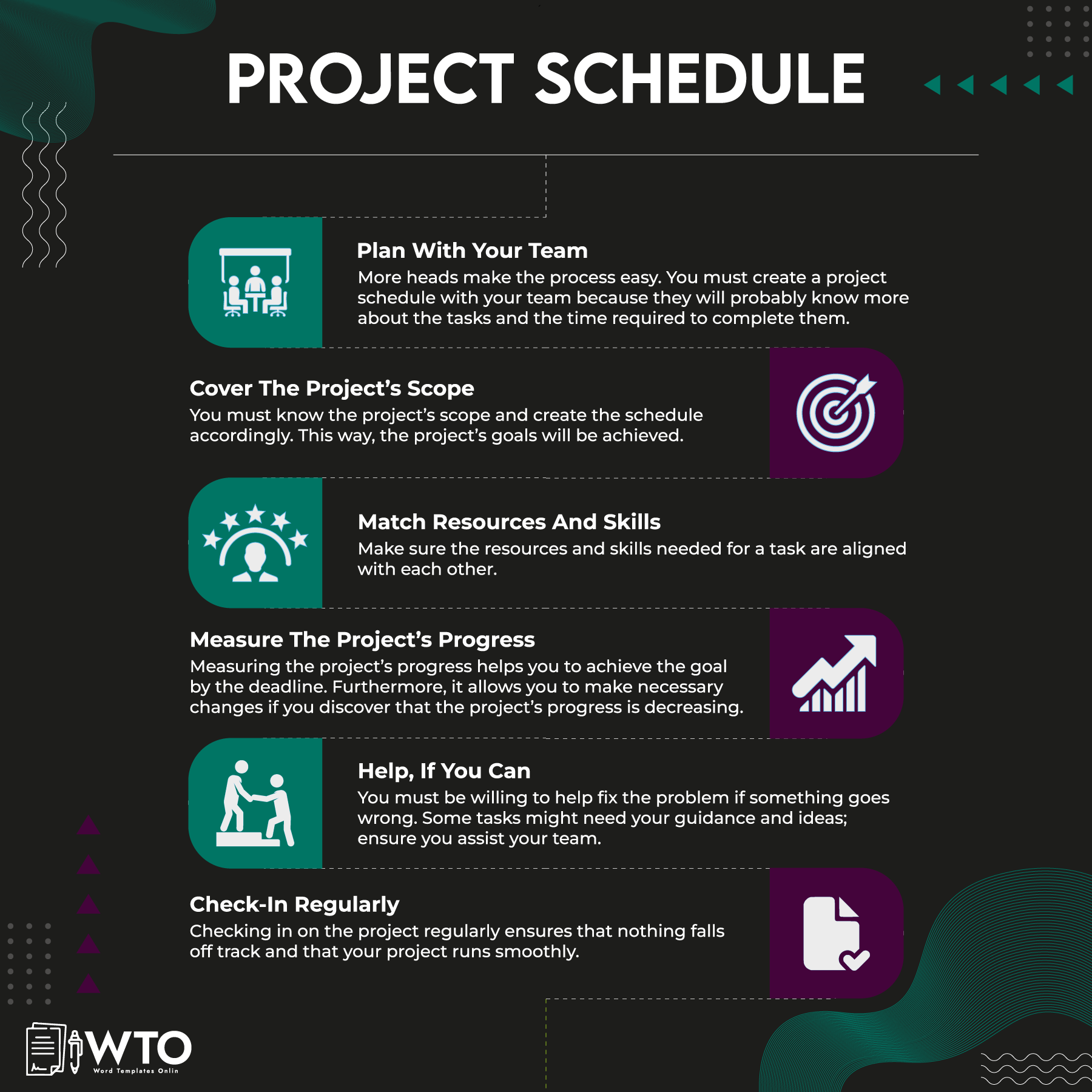
Wrapping Up
A project schedule is essential for any manager. It dictates the outcome of the entire project. The manager needs to create a schedule that complements the project’s objectives. A schedule simplifies the project’s demands and allows the involved parties to know what to do and when to do it.
Furthermore, with a well-prepared schedule, you will acquire the right team and resources to complete the tasks. As a result, you will be able to meet the set deadlines and deliver the expected results. Note that the schedule saves you time, money, and resources. Therefore, it is fair to say that a well-prepared schedule plays a significant role in the project’s success.




